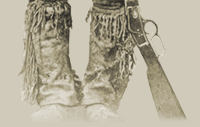|

[ Project Plans | Essential
Questions | Knowledge Hunt | Glossary
| Links ]
Drilling into Reserves: How Do We Find Oil?
Researching Hydrocarbon Natural Resources by Examining the Life
and Work of Dr. Helen Belyea
Introduction
Students need to value and appreciate the variety and abundance
of Alberta's natural resources and demonstrate care and concern
for the environment through their choices and actions. They will
analyze how Albertans interact with their environment exploring
how Albertans deal with competing demands on land use and natural
resources. What are the significant natural resources in Alberta?
Where are they located? How are natural resources used by Albertans?
What natural resource issues will we have to solve in the future
of our province or world?
Project Explanation
In this project, students will develop an appreciation of the non-renewable
hydrocarbon-based natural resources in Alberta through an examination
of the life of Dr. Helen Belyea, an Alberta geologist who was very
important in the oil patch. They will then research one hydrocarbon-based
natural resource and examine its impact on the province of Alberta.
Alberta Social Studies Curriculum Unit Connections
Grade Four - Alberta: The Land, Histories and Stories
4.1 Alberta: A Sense of the Land
4.2 The Stories, Histories and People of Alberta
4.3 Alberta: Celebrations and Challenges
Grade Five - Canada: The Land, Histories and Stories
5.1 Physical Geography of Canada
5.2 Histories and Stories of Ways of Life in Canada
Materials and Resources Needed
Procedures
Students will create a research presentation consisting of two
parts. First, they will introduce and describe Dr. Helen Belyea,
a geologist in Alberta from 1950 to 1982. Second, they will organize
for their classmates a short presentation on a hydrocarbon natural
resource in Canada. The teacher may introduce the project by asking
students if they know some of the natural resources are that are
abundant in the province of Alberta and how they are be used by
human beings. The CBC archives page has television and radio clips
about the oil sector in Alberta and would allow students to get
a visual understanding of the importance of oil in Alberta. The
following scenario may then be presented:
Drilling Into Reserves Project Scenario
You are a geologist and a colleague of Dr. Helen Belyea, one of
the first female geologists in a field dominated by men. A classroom
teacher has asked you to come and discuss with their students the
life of the Maverick Dr. Belyea. As you are also very knowledgeable
about hydrocarbon natural resources such as oil and natural gas,
you have also volunteered to make a presentation for the children
about one of the following:
- Oil (crude oil)
- Natural Gas
- Oil Sands
- Offshore Oil Drilling
Using the Mavericks: An Incorrigible History of Alberta
site, research about Dr. Belyea. The following questions may help
to guide you:
- Who was Dr. Helen Belyea?
- What is the science of geology?
- How did she start out in the geology field?
- How did her geological work help to find where oil was underneath
the ground?
- Why was she a Maverick?
Using other web resources such as the sites in the Mavericks: An
Incorrigible History of Alberta Internet Resources, research about
the hydrocarbon natural resource you have chosen. The following
questions may help to guide you:
- What is ______?
- How was ______ formed or created?
- How do scientists find ______? Has this changed over the last
100 years?
- How is ______ produced?
- How is ______ transported?
- How is ______ refined (made free of impurities)?
- How do human beings use ______?
- How has the ______ industry affected the environment?
- How could the ______ industry affect the environment in the
future?
- What is the future like for the ______ industry?
- How will this natural resource industry affect the province
of Alberta?
You will need to decide how to present your research to the class
of students. Some options include creating a speech, a poster, a
picture book, a pamphlet, a PowerPoint presentation, an Inspiration
mind map, or even a web site.
Assessment and Evaluation
- Students and their teacher should develop their own rubric by
identifying evaluation criteria for the project that will match
their own learner outcomes. This allows students to understand
the expectations for their work and to have input into the ongoing
evaluation process.
- Individually or in small groups, students might evaluate the
work of two or three other students in order to gain insight into
how their peers approached the project.
- After completing the project, students may talk or journal about
what they felt they did very positively, what they had difficulty
with, and how they would change how they would approach a similar
project in the future.
- The final student presentations may be videotaped in order to
be shared, re-examined, and evaluated. These may also be shared
or evaluated along with their parents or be presented at student-led
conferences.
Ideas for Enriching this Project
- Students could undertake the project in the Oil & Gas project
#3 - Saving the Environment One Maverick at a Time… Examining
Oil's Impact on the Environment and Taking Action for Conservation
& Preservation.
- Students could examine the issue as to whether the idea of
"Peak Oil" is true and how we could approach this potential
problem. The theory of Peak Oil is that we have used or are coming
close to using over half of the total oil reserves in the Earth.
They could examine the British
Newspaper Article "The End of Oil is Closer Than You Think"
from Thursday April 21st, 2005, and discuss the implications.
 |



![]()
